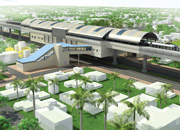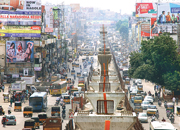Naresh Kuruba, Research Scholar, CEPT University and Shalini Sinha, Associate Professor, CEPT University assess the applicability and acceptability of Bike and Ride (B&R) facilities in case of Ahmedabad city.
Public transit is not designed to provide a door-to-door connectivity unlike personalized modes of transport. Access and egress are the weakest links in public transit and it is recommended to have feeder services. Different kinds of feeder modes are available to provide accessibility to the public transit. Improving each of these feeder modes will make a public transit more accessible.
Walking is the basic mode of transport used to access public transit stops. But, it has limited coverage area. So, the study has considered, bicycle as an access mode to public transit because of its larger coverage area than walking.
“Bike & Ride” allows you to park your bicycle at bicycle parking facility and transfer to the bus for rest of your trip. You pay a normal bus fare, with no additional charge to park your bicycle at the parking facility. Integrating bicycle and public transport consists of many links (see Figure 1).
Bike and Ride Services
“Bike and Ride” services can be broadly classified into four categories based on types of integration, types of parking, various ideal combinations and station typology. Several factors directly or indirectly influence the choice of bicycle as an access mode to public transport
CASE STUDY: AHMEDABAD
Ahmedabad has a recently developed Bus Rapid Transit System (BRTS) which along with the city bus services is serving the mobility needs of the people. Site selection for carrying out surveys was based on parameters like proximity to the BRTS stations, land use, socio-economic profile of the area and bicycle ownership levels.
Prioritizing BRT Stations
A total of four stations of different typologies – terminal, interchange station, terminal cum interchange station and a regular intermediate station were selected. An initial sample survey of households at the selected stations was carried out to ascertain willingness to use cycles as a feeder mode for their journeys. The survey showed the potential users were relatively high at interchanges. The Sola Cross Road interchange was selected for further study.
The study area has a population of 56,790 (2006) within an area of 2.04 sq.km. The interval of 0 – 0.5 km is considered as walkable and from 0.5 km upto 1.5 km has been consider for conducting the household survey. In each zone 2% samples were selected. A total of four routes meet at Sola Crossroads connecting this area to various educational and employment centers. The average number of boardings on BRT at this stop was 2200 passengers/day (January, 2014).
This catchment area was divided into smaller zones for further analysis. Around 2% households of the estimated households in the study area zones were surveyed.
A total of 188 households were surveyed in the study area and 309 household members were sampled. Of these 85% of the household members are two wheeler users and 15% are car users. At an aggregate level, 12% of the two wheeler users were willing to shift to B&R facilities.
BRT Coverage at Egress Distance
 While assessing the shift of people to B&R, egress distance was also considered. People would have a likelihood of shifting only if the destination is within walking distance of the alighting BRT station. For this purpose catchment area for existing as well as planned (proposed) network of BRT was identified.
While assessing the shift of people to B&R, egress distance was also considered. People would have a likelihood of shifting only if the destination is within walking distance of the alighting BRT station. For this purpose catchment area for existing as well as planned (proposed) network of BRT was identified.
As per the sample survey, a total of 61% trips lie within walkable egress distance of the proposed BRT network. Of these, 12% of the trips were willing to shift to B&R services.
 TrafficInfraTech Magazine Linking People Places & Progress
TrafficInfraTech Magazine Linking People Places & Progress





